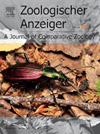安第斯高山喙甲虫支系的起源和早期分化:Corisantis gen.nov.、系统发育和历史生物地理学
IF 1.5
3区 生物学
Q2 ZOOLOGY
引用次数: 0
摘要
描述并说明了喙甲亚目 Philonthina 的安第斯支系(AC)中的一个新属 Corisantis gen.该新属包括以前归入 Belonuchus Nordmann(B. candens (Erichson, 1840) 和 B. pulchripennis Bernhauer, 1908)和 Philonthus(Ph. auripennis Bernhauer, 1916; Ph. caliensis Bernhauer, 1916; Ph. excellens Bernhauer, 1916; and Ph. whymperi Sharp, 1891)的 6 个有效种,以及 9 个新描述的种:C.ancashensis新种、C. bongarensis新种、C. cajamarcanus新种、C. columbiensis新种、C. ecuatoriensis新种、C. grandis新种、C. levis新种、C. magdalensis新种和C. napoensis新种。最初归入 Philonthus 的 4 个种被重新归入 Corisantis,并有以下新组合:C.auripennis(Bernhauer,1916)comb. nov.、C. caliensis(Bernhauer,1916)comb. nov.、C. excellens(Bernhauer,1916)comb. nov.和 C. whymperi(Sharp,1891)comb. nov.。此外,Belonuchus pulchripennis 被同义为 Belonuchus candens (=B. pulchripennis syn. nov.), 它也被转到 Corisantis 作为 C. candens (Erichson, 1840) comb.Lectotypes are designated for B. pulchripennis Bernhauer (1908), Philonthus candens Erichson (1840) and Philonthus whymperi Sharp (1891).本研究为 Corisantis 的物种提供了诊断、重新描述或描述、插图、分布图和鉴定检索表。系统发生分析采用了三种方法--最大似然法、最大似然法和贝叶斯推断法--一致支持 Corisantis 的单系,并确认了它与 Leptopeltoides Chani-Posse 和 Asenjo 的姊妹群关系,这两个属都是 Leptopeltus Bernhauer 的姊妹属。此外,利用贝叶斯二元 MCMC(BBM)和 S-DIVA(统计散布-方差分析)两种方法进行的生物地理学分析表明,南美洲过渡带是这三个属的起源和早期多样化的中心。本文章由计算机程序翻译,如有差异,请以英文原文为准。
Origin and early diversification of a high Andean rove-beetle clade: Corisantis gen. nov., phylogeny, and historical biogeography
A new genus, Corisantis gen. nov., within the Andean clade (AC) of the rove-beetle subtribe Philonthina, is described and illustrated, including 14 species. This new genus comprises six valid species formerly assigned to Belonuchus Nordmann (B. candens (Erichson, 1840) and B. pulchripennis Bernhauer, 1908) and Philonthus (Ph. auripennis Bernhauer, 1916; Ph. caliensis Bernhauer, 1916; Ph. excellens Bernhauer, 1916; and Ph. whymperi Sharp, 1891), along with nine newly described species: C. ancashensis sp. nov., C. bongarensis sp. nov., C. cajamarcanus sp. nov., C. columbiensis sp. nov., C. ecuatoriensis sp. nov., C. grandis sp. nov., C. levis sp. nov., C. magdalensis sp. nov., and C. napoensis sp. nov. The four species originally classified under Philonthus are reassigned to Corisantis with the following new combinations: C. auripennis (Bernhauer, 1916) comb. nov., C. caliensis (Bernhauer, 1916) comb. nov., C. excellens (Bernhauer, 1916) comb. nov., and C. whymperi (Sharp, 1891) comb. nov. Additionally, Belonuchus pulchripennis is synonymized under Belonuchus candens (=B. pulchripennis syn. nov.), which is also transferred to Corisantis as C. candens (Erichson, 1840) comb. nov. Lectotypes are designated for B. pulchripennis Bernhauer (1908), Philonthus candens Erichson (1840) and Philonthus whymperi Sharp (1891). This study provides diagnoses, redescriptions or descriptions, illustrations, a distribution map, and an identification key for the species of Corisantis. Phylogenetic analyses, employing three methodologies—Maximum Parsimony, Maximum Likelihood, and Bayesian Inference—consistently support the monophyly of Corisantis and confirm its sister-group relationship with Leptopeltoides Chani-Posse and Asenjo, with both genera being sister to Leptopeltus Bernhauer. Additionally, biogeographical analyses using two methodologies—BBM (Bayesian Binary MCMC) and S-DIVA (Statistical Dispersal-Vicariance Analysis)—suggest that the South American Transition Zone was the center of origin and early diversification for these three genera.
求助全文
通过发布文献求助,成功后即可免费获取论文全文。
去求助
来源期刊

Zoologischer Anzeiger
生物-动物学
CiteScore
2.80
自引率
7.10%
发文量
75
审稿时长
>12 weeks
期刊介绍:
Zoologischer Anzeiger - A Journal of Comparative Zoology is devoted to comparative zoology with a special emphasis on morphology, systematics, biogeography, and evolutionary biology targeting all metazoans, both modern and extinct. We also consider taxonomic submissions addressing a broader systematic and/or evolutionary context. The overall aim of the journal is to contribute to our understanding of the organismic world from an evolutionary perspective.
The journal Zoologischer Anzeiger invites suggestions for special issues. Interested parties may contact one of the editors.
 求助内容:
求助内容: 应助结果提醒方式:
应助结果提醒方式:


